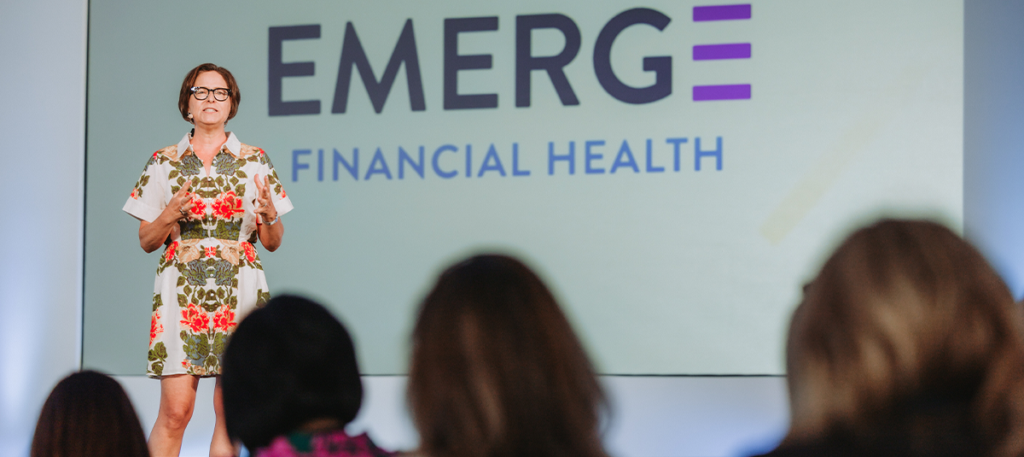
Small Change, Big Impact
Good afternoon, and welcome to San Diego.
Being at EMERGE is my absolute favorite moment of the year, because coming together as a community helps ground me in our shared purpose of financial health for all. That’s especially true this year, as we make our way in a world marked by turbulence and uncertainty. It’s challenging to navigate through all of the news and the noise and find True North. For me, nothing helps clarify my priorities more than listening to the people we serve.
That video was a real wake-up call. Losing everything in a storm. Struggling under the weight of debt. Holding a family together while going without the essentials. Listening to those stories, seeing the looks on their faces, I could sense just how overwhelmed they are.
These stories are not exceptions. They are the reality for tens of millions of people. As financial health professionals, it can feel equally overwhelming to figure out how to be part of the solution against a backdrop of on-again off-again tariffs, the threat of a recession, and a rise in the frequency and severity of catastrophic storms and wildfires. In moments like these, it’s tempting to stay in bed and hide under the covers.
But we simply cannot allow the uncertainty and the uproar to paralyze us. There’s no cavalry on the horizon; the responsibility to meet the moment is ours and ours alone. Even if the actions we take feel small relative to the size of the problem, we must act. Because small actions – when taken with intention – can have outsized impact.
Let me show you what I mean. Every day in the United States, two people are killed by drivers running red lights. About 30 years ago, cities across the country took action. They installed red-light cameras at busy intersections, betting that the threat of a ticket would make us brake. The cameras flashed, tickets piled up, city coffers filled — yet crashes hardly fell.
So engineers tried a different angle: They shifted their focus away from the red light and instead experimented with increasing the duration of the yellow light, giving drivers more time to get through the intersection before the light turned red. It turns out that, by letting the yellow light shine for as little as 1 second longer, crashes were reduced by 40%.
Small change, big impact.
If traffic engineers could save more than 300 lives a year with a simple, one-second
adjustment, imagine the impact you could have on the financial lives of your customers and your workforce by making small but meaningful changes to your products and benefits. What is the equivalent in your work of adding one second to the yellow light?
What if you gave your borrowers the power to choose their own due dates for their monthly loan payments? It may sound obvious, but most auto loan payments are due on the date the borrower drove the car off the lot. Convenient for lenders, but stressful for borrowers. Put yourself in your customer’s shoes: You purchase the car on the 12th but your paycheck doesn’t arrive until the 15th. Every month, that three-day gap creates anxiety — will I have enough money in my account to make payment? Will I be hit with a late fee if I don’t? Will the bank repossess my car?
Beneficial State Bank decided to flip the script. During the standard welcome call bankers make to new loan customers, the bank texted borrowers a simple form to choose a payment date timed to their pay schedule. A control group kept the old process. The results were remarkable. According to research from Common Cents Lab at Duke University, borrowers who received the form and signed up had 27% fewer late payments and paid 10% more toward their debt. That meant fewer late fees and better credit scores for customers, and fewer delinquencies and chargeoffs for the bank.
Small change, big impact.
What if consumers could see both the perks AND the drawbacks of financial products side by side? Too often, customers are wooed with rewards while being left to guess at the risks. Commonwealth Bank of Australia set out to test the power of transparency in helping consumers choose the right credit card. Some shoppers saw the standard marketing display of the bank’s credit card options and the advantages of each. Others saw a version that also included information on the tradeoffs. The results were powerful. Consumers who saw the tradeoffs were 10% less likely to make late payments while spending nearly 10% more each month, and they were 20% less likely to cancel their cards after nine months.
Small change, big impact.
These examples remind us that we don’t need to wait for sweeping policy reform, or multi-million dollar investments, or our company’s next strategic planning process to drive positive financial health outcomes for our customers and our workers. We can start now – by making relatively small, thoughtful, human centered choices in our everyday work.
Imagine a future where every financial product is intentionally designed to improve financial health. It starts with examples like these. But it can’t end there. The moment we’re in demands more than individual success stories. It demands that we harness the power of our collective action to build an economy that works for everyone. To do that, we need more than good intentions. We need standards.
Standards have the power to drive systemic change. From building codes to nutrition labels to traffic lights, standards have revolutionized industries by setting clear expectations and incentives that shape behavior.
In today’s relaxed regulatory environment, aligning with financial health standards is even more important for building trust, strengthening customer relationships, enhancing brand value and improving long term performance. With standards in place, financial health can become the norm.
In partnership with all of you, the Financial Health Network has been building toward standards for two decades. We have created principles and frameworks. We have partnered with dozens of organizations to test what works, and we have created best practice guides based on the results.
We also have collaborated with JD Power to identify the kinds of financial health experiences that drive customer satisfaction. The data demonstrates a strong business case. Satisfaction increases by double digits when a customer uses just one bank tool. In fact, financially healthy customers experience the biggest jump. But these tools also drive meaningful improvements in satisfaction for those who are financially challenged. For instance, financially vulnerable customers who use their Bank’s digital budgeting tool to help manage their spending experience a 34% increase in satisfaction.
Small change, big impact.
Financial providers have so many ways they can be part of the solution. Now it’s time to codify them. And so, today, I’m thrilled to share with you a brand new set of standards for designing checking accounts and credit cards that help consumers spend well. Developed with input from an advisory board of your peers, these standards provide clear, actionable guidelines for designing for the account features and policies, and onboarding and accessibility practices that have been proven to make a positive difference in people’s financial lives and to your bottom line.
For instance, one of the standards enables customers to choose their monthly due date for their credit card payment, like Beneficial State Bank does for auto loans. Another standard increases transparency for consumers by sharing checking account and credit card tradeoffs like Commonwealth Bank of Australia does.
To be clear, this isn’t a compliance exercise. It’s about building profitable businesses that drive impact. These standards are intentionally designed to be adaptable—offering pathways for both incremental improvement and bold innovation, while collectively transforming industry practice.
At the end of the summer, we will publish an initial assessment of how the largest banks and credit unions perform against these standards – Not to call anyone out, but to call everyone forward. Because transparency is the first step toward accountability, and accountability moves us from intention to measurable impact.
So let’s get started. Please take a moment to download the standards by scanning the QR code on the screen. Join the breakout session on standards tomorrow afternoon for a deeper dive. Then use the scorecard we provide in the report to assess how your institution’s products stack up.
My ask is that, by the end of the year, your institution commits to adopting at least one of the standards it isn’t yet meeting. When we come back together a year from now for our next EMERGE conference, I want to be able to celebrate our progress in putting proven ideas into widespread practice and raising the bar for what good looks like.
Our vision is to build a comprehensive library of standards–not just for checking accounts and credit cards–but for every product that shapes a person’s financial life. The standards we are releasing today are just the first step, and they are only as powerful as the people who bring them to life. That’s you, and it’s your voices and your leadership that’s needed right now.
Over the next three days, you’ll hear directly from consumers, many of whom are your
customers, about their lives, challenges, and aspirations. Listening deeply to their stories is essential for understanding the real-world needs our products and solutions must address. But listening alone isn’t enough. We must act.
Each of us can drive small changes that make meaningful impact. Yet to truly transform financial health levels in America, we must come together and embrace standards that unite our industry in purpose and practice. Together, we can, and we will create financial health for all. Onward!
